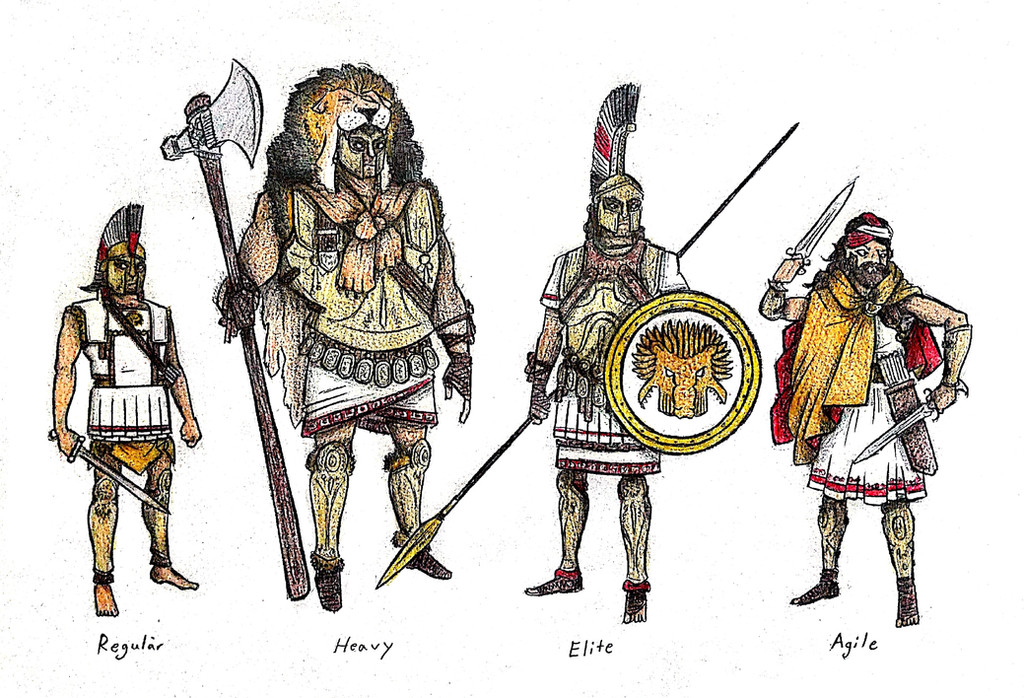HOME | DD
 Avapithecus — Samian Hoplites
Avapithecus — Samian Hoplites

#character #design #greek #history #hoplite #referencesheet #samos #soldiers #warriors
Published: 2023-05-16 16:42:22 +0000 UTC; Views: 5431; Favourites: 109; Downloads: 0
Redirect to original
Description
Though often overshadowed by the later successes of other ancient superpowers like Athens and Sparta, the island city-state of Samos had a remarkable, if brief, time in the sun of its own. Though the island had been inhabited since at least the 3rd millennium BCE, most local histories begin around the 7th century BCE. It was around this time, possibly earlier, that the famous Heraion, or Temple dedicated to the goddess Hera, was built. Legend says that Hera was born on the island underneath a sacred tree which supposedly was still standing outside the Temple by the time of Pausanias in the 2nd century CE. The Temple was one of the oldest and largest of what we today would consider a classical Greek temple, though sadly archaeological and literary remains are now quite scant. The Temple and similar architectural marvels were supported by Samos's natural position smack in the middle of important trade routes from the Mediterranean to the Aegean to the Black Sea, and that wealth earned them power and prestige. Samos boasted many renowned thinkers during this time, including the legendary Pythagoras and the Halicarnassus-born Herodotus.By the mid 6th century BCE, a man named Polycrates had ascended to the position of Samos's tyrant. Under his reign, he transformed the island into a naval superpower, crafting a fleet of triremes which pushed competition like their rivals in Miletus quite literally out of the water. Polycrates was also a shrewd politician, forming a military alliance first with Pharaoh Amasis II, then with the Iranian shah Cambyses II. The sources are a little unclear as to why he abandoned Egypt in the wake of the Persian invasion, but I suspect he was smart enough to know when his friends were outmatched and which side of the carnage he wanted to come out on. Polycrates was overthrown when Darius came to power in Iran in 522 BCE, and Samos became a de facto vassal of the Achaemenid Empire. The city would revolt with the other Ionian states during the Greco-Persian Wars, but it would never again reach the heights it did under Polycrates. In the 5th century, Samos enjoyed a stint in the Delian League before Athens did what Athens did and backpedaled on them when it suited their interests. The great general Pericles himself was sent to subdue the island in 440 BCE, and sent Samos to their room promising that they'd be a good little vassal from now on. As bigger and badder powers usurped each other in the following centuries, that's pretty much the only role Samos would play from then on out, a once great corner of the Aegean reduced to a province among many islands.
Design notes, sometimes I feel like I painted myself into a corner with this format for designing factions, but I'm too stubborn to change it now. Minor city-states like Samos who barely make a blip on the modern historical drama don't really have a lot of distinguishing reference images to draw from. Most often they're just depicted as the most generic examples of warriors and armor from the time period. I found like one page in one book featuring one design of a Samian hoplite, but I couldn't even find the actual title of the book to credit. I used that as reference for the regular, and for the elite I referenced an extremely worn down statue of a hoplite from Samos housed in the Altes Museum in Berlin. Everything else, I mostly improvised. That lion symbol is an archaeologically attested icon for the city-state, most commonly found on coinage from the time, so I figured I'd design one of them with a lion skin draped over their helm like Hercules. Everything else, I kind of improvised, and yeah it shows. Certainly could've been a lot more buffed out, but for D&D tokens, they worked well enough.






















